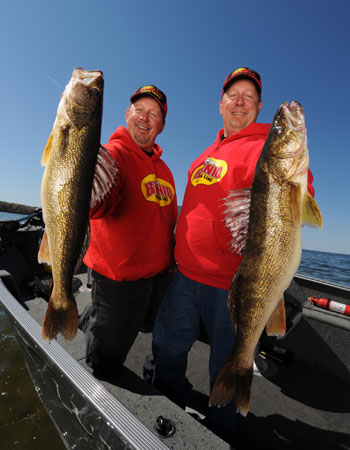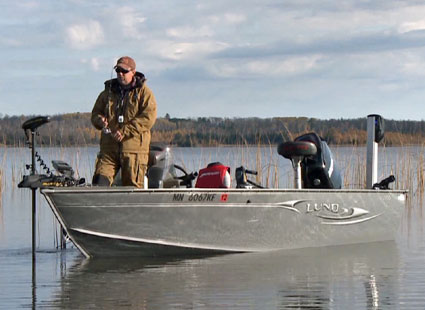In this two-part article I will discuss how one of the best early-season walleye bites coincides with the shiner spawn each year. Part one will concentrate on the all-important when and where; part two will explain the how, giving you the exact presentations to take full advantage of this phenomenal bite.
 It’s sad but true: One of the greatest fallacies in walleye fishing—anglers’ reluctance to fish skinny water—prevents most guys from experiencing the walleye feeding frenzy that occurs in waist-deep waters each year.
It’s sad but true: One of the greatest fallacies in walleye fishing—anglers’ reluctance to fish skinny water—prevents most guys from experiencing the walleye feeding frenzy that occurs in waist-deep waters each year.
But that doesn’t have to be the case.
Timing is key. Fish operate on a calendar, Mother Nature operates on a calendar—but when it to comes to spawning—fish relate to temperature more than any other factor.
I’ve learned to closely monitor water temperature from years of steelhead fishing. Walleye fishing is no different. Key temperatures signal movements that can mean extraordinary fishing. Start paying attention and the game becomes simple connect-the-dots.
Whether it’s a hand thermometer like I carry on steelhead rivers or the display on a Lowrance, keep a close eye. Over time you’ll notice that water temp is often as important—if not more so—than depth, which we’ve come to rely on so heavily as walleye anglers.
For example, I know that when the water reaches 53- to 55-degrees, a biological alarm clock sounds and spottail shiners migrate en masse to spawn in areas of downed bulrush stands and spotty grass on sand flats—and with them, pods of ravenous walleyes looking for an easy meal.
Although it can vary a bit with water clarity, I’ve found this typically occurs in the 3- to 5-foot range, areas outside the comfort zone of most walleye sticks. And in stained water waters you can find this bite even shallower.
Here’s the rationale. Bulrush stands—bent over by sheets of ice and wind—provide cover, retain heat and provide the ideal conditions for bug hatches that draw in forage fish. And it doesn’t take walleyes long to figure out the location of this early-season all-you-can-eat buffet.
But not all bulrush stands are buffet lines.
I look for smaller islands of bulrushes rather than the large expanses you’d ply for spring crappies or bass. Find a big flat that extends off the shoreline surrounded by deeper water and you’re in the zone. Choppy days are extra credit—the movement of warm water off the shore into these smaller bulrush stands can mean game on.
Stop, Look and Glisten
Next to not fishing shallow enough, one of the biggest fallacies in walleye fishing is the notion that you have to drift or troll to catch fish. Not true in shallow water. Make too much noise, get too close, and you’ll blow out the fish. And on these flats walleyes disperse quickly. The key is stealth; think spot and stalk hunting.
Don’t neglect a good pair or polarized glasses so you can locate dark spots of bulrushes and sand grass. I’m a big proponent of electronics, but the good Lord gave you a pair of legs and eyes, so stand up and scan where those fish might be. On calmer days with a little bit of sun you can see the shiners from a long way away, the sun glistening off their pearlescent scales.
Make sure to shut off your outboard and quietly engage your electric long before you reach any of these potential fish-holding spots. How close? You want to make the longest casts you can, typically 90-110 feet.
Wherever possible, position the wind at your back for Hail Mary casts. Since you’re looking for a windblown shore rather than an offshore wind, this isn’t difficult. The problem is making sure your boat doesn’t shift downwind, leaving you casting over the back of the boat.
A lot of guys will use the Spot Lock on their Minn Kota bow-mount trolling motor—and you can deploy your bow and stern anchors—but that takes up a lot of time as you move spot to spot.
That’s where the 8-foot Minn Kota Talon really shines. I can move in with the electric, punch the button on the Talon and then fan cast from the front of the boat until I need to move to another spot. This enables me to keep the boat nose down and make a lot longer casts with light jigs and light line. Moving takes seconds. Simply punch the button again to lift the Talon, engage the Terrova, slowly cruise to the next spot and deploy the Talon again. Hover, hold, cast and repeat.
Hey, if it takes stealing boat control tactics from the bass and inshore guys to catch more walleyes, count me in!
Now that we’ve covered the when and where, check out the how in part two of “One-Two Punch: Wrangle ‘Eyes with Shiners.”










